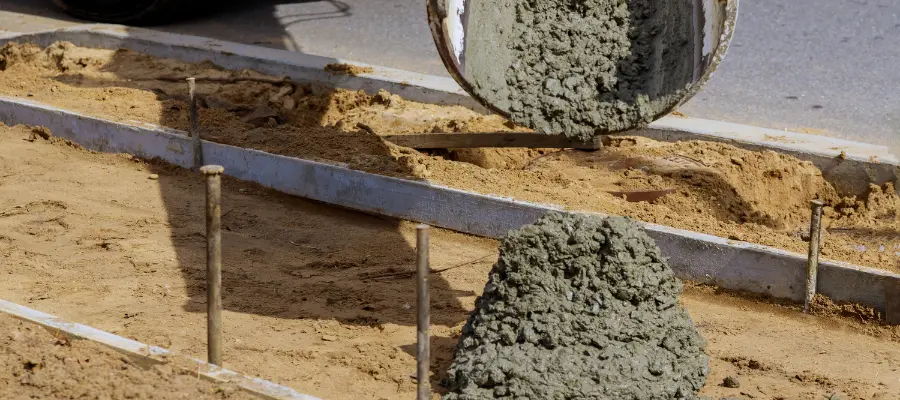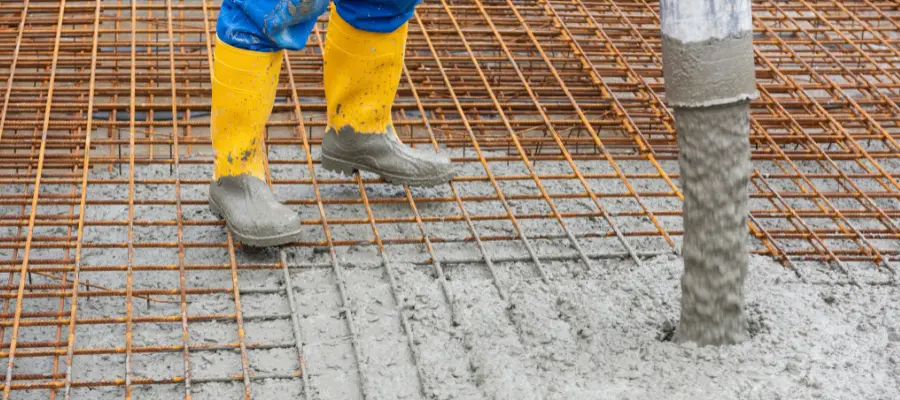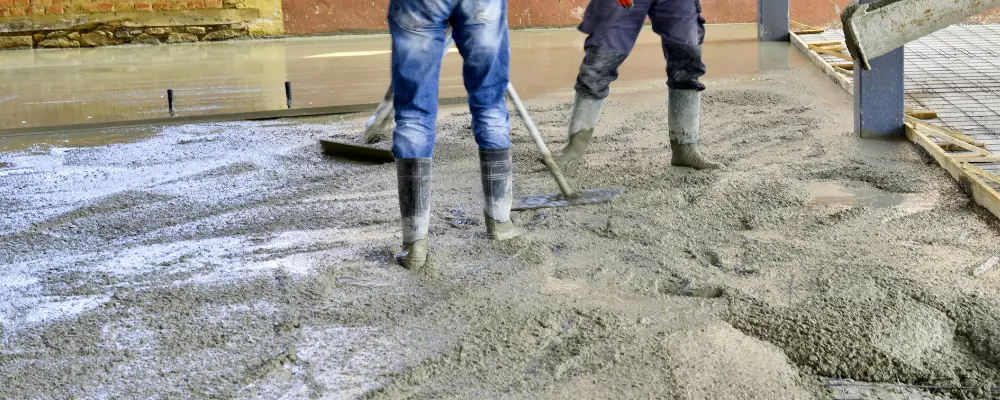Concrete is one of the major construction materials. To improve its strength and durability, you need to remove the air voids that entrap in the concrete mixture. Proper compaction is also necessary to achieve the required properties of concrete.
In today’s blog of Brick & Bolt, you are going to understand different types of compaction of concrete and factors influencing the choice of concrete compaction method.
What is Concrete Compaction?
Compaction is the process that eradicates entrapped air from freshly placed concrete and consolidates the aggregate particles together to increase the density of concrete. The compaction of concrete can remove the voids, improve the density, and offer better adhesion between aggregates and cement mixtures to increase the lifespan of the building.
What is the Compaction Factor?
The compacting factor can be defined as the ratio of the weight of moderately compacted concrete to the weight of fully compacted concrete.
A compaction factor test is conducted in labs to find the compaction factor of concrete. The compaction factor value shows how readily the concrete can be compressed. A higher compaction factor indicates better workability, which means the concrete is easier to work with and to shape.
The value of the compaction factor of concrete ranges between 0.7 and 0.95
| Workability | Compaction Factor |
| High | 0.95 |
| Medium | 0.92 |
| Low | 0.85 |
| Very low | 0.78 |
Different Types of Compaction of Concrete

The following are the major types of concrete compaction methods.
Hand Compaction or Manual Compaction of Concrete
Hand compaction is also called manual compaction of concrete. This concrete compaction method is suitable for small quantities of concrete, but it demands more water content. It can be performed in the following three ways.
- Rodding
- Ramming
- Tamping
1. Rodding
Rodding involves the use of a 2m long and 16 mm diameter steel rod with sharp corners and edges. The thickness of layers for rodding will be 15 to 20 cm. This steel rod is used to compact freshly placed concrete. Rodding is used to compact the edges and corners of concrete cubes. It is also used for compacting precast concrete blocks.
2. Ramming
Concrete should be rammed to drive out any entrapped air bubbles when it is placed. The ramming of concrete depends upon the water-cement ratio of the concrete. If the water-cement ratio of concrete is high, the aggregates drop down at the bottom, and cement slurry may appear at the top layer. It may result in poor concrete strength, which may decrease the service life of a house or building. It is commonly used for compaction on the ground in plain concrete. It is not used in Reinforced Cement Concrete(RCC) or on higher floors.
3. Tamping
Tamping is used to compact the roof, floor slab, or RCC road pavements where the thickness of concrete is moderately less, and the surface is to be finished smooth and level. It is performed with a 10 x 10 cm wooden cross beam.
Concrete Compaction by Pressure and Jolting
Pressure and jolting are concrete compaction methods generally used in laboratory settings or precast concrete manufacturing. Here, pressure or impact loads are applied to the concrete to eliminate air voids to achieve uniform density.
Jolting and vibrating tables are used in the production of precast concrete. The concrete is placed on these tables, and quick vertical vibrations are applied, forcing the mixture to settle and release any trapped air. This concrete compaction process is commonly used to create high-performance concrete that demands precise compaction for maximum strength and durability. Pressure and Jolting methods of compaction are mainly used for the compaction of hollow blocks, concrete blocks and cavity blocks.
Concrete Compaction by Spinning
In these types of concrete compaction, compaction is performed by spinning. This method allows a concrete-filled mould to rotate or spin at a high speed. The centrifugal force, a crucial element in this process, effectively eradicates the entrapped air voids and consolidates the concrete. This method offers high-performance concrete. Generally, this method is useful in the precast concrete manufacturing process.
Mechanical Compaction by Vibration
In these types of compaction of concrete, the concrete compaction machines are used for vibration. This method is very helpful to get effective compaction in concrete.
The following are the major types of vibrators used in this method:
Needle Vibrator
Needle vibrators are also called internal or immersion vibrators. These vibrators have a vibrating head coupled to a flexible shaft. The vibrating head is driven into the concrete at regular intervals, causing the vibrations to liquefy the mixture, eliminate air voids, and produce uniform concrete compaction. These vibrators are commonly used for compacting large, flat surfaces, such as slab foundations.
Surface Vibrator
Surface vibrators, also named screed or pan vibrators, are concrete compaction machines used to compact different types of concrete slabs, pavements, and flat surfaces. These vibrators move across the concrete surface, levelling it and removing air voids at the same time. Surface vibrators are best for creating a smooth finish on broad horizontal surfaces.
Formwork Vibrator
Formwork vibrators are also called external vibrators. They are specifically designed for compacting concrete in formwork. These concrete compaction methods are utilised to enable the right concrete compaction around embedded reinforcement while also providing a smooth surface finish. Formwork vibrators are vital for producing high-quality concrete parts like walls, beams, and columns.
Table Vibrator
Table vibrators are used to compact granules, which requires controlled vibrations. The concrete is put on a vibrating table, causing vibratory action across the entire surface. The motion of this concrete compaction method effectively eliminates voids and improves density, resulting in good concrete compaction through vibration in thin sections.
Factors Influencing the Choice of Concrete Compaction Method

Choosing the right concrete compaction methods depends on the following factors:
- Type of concrete mix
- Project scale and type
- Equipment Availability
Type of Concrete Mix
Different mixes, such as M20 Concrete mix and M25 concrete mixes, will have varying workability levels, impacting how easily the concrete can be compacted. For workable mixes, manual methods will be sufficient. But for low-workability mixes, mechanical methods are often required.
Project Scale and Type
The scale and nature of the construction project impact the choice of compaction method. Simpler mechanical compaction methods can be sufficient for smaller projects, such as small home foundation. However, advanced mechanical methods are essential for large-scale projects. Surface vibrators may be more suitable for slabs, whereas thick, substantially reinforced portions may require interior vibrators to adequately reach all areas.
Equipment Availability
The availability of compaction equipment is another important consideration. Not all construction sites have access to the same level of technology, which can influence the choice of method. The cost and availability of renting equipment can also be important considerations.
Conclusion
Proper compaction, with the different types of compaction of concrete, is very important to accomplish the required strength and durability in construction projects. By successfully removing entrapped air with the compaction method, the concrete density can be improved, leading to better bonding between aggregates and cement. Builders may create high-quality, long-lasting concrete structures by understanding and executing proper compaction processes.
Anyone who does not want to make any compromises with regard to the safety factor is required to have an understanding of the various types of compaction of concrete. Hence, it’s recommended that you hire a skilled team of professionals like Brick & Bolt Hyderabad to evaluate the different types of compaction of concrete and give you a strong and long-lasting structural design according to your house floor plan design.

